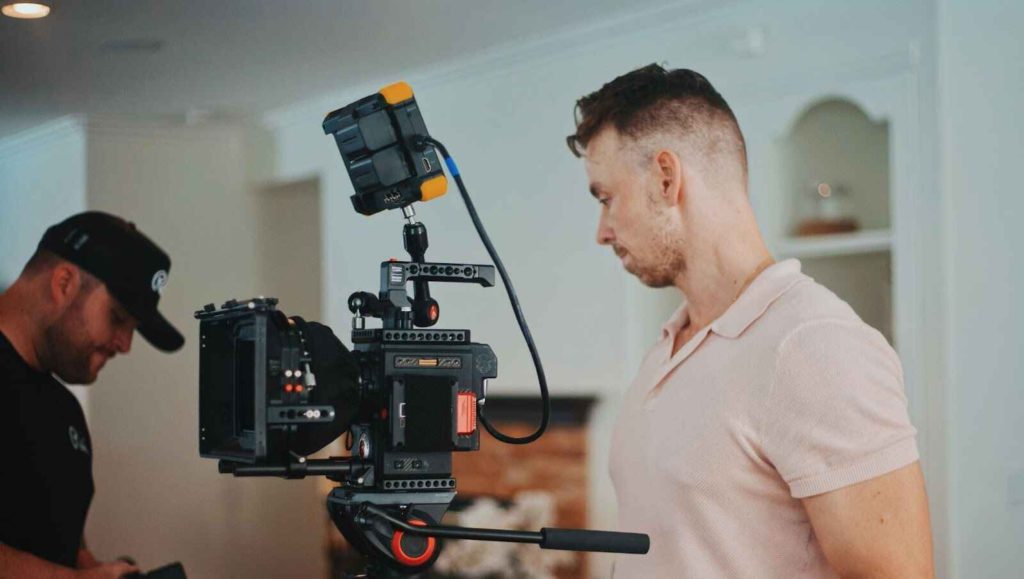We’ve all seen those painfully awkward corporate videos with forced smiles, robotic scripts, and production value that screams “we made this in 2003.” They’re the videos employees refuse to share on social media, and customers click away within seconds.
Yet companies continue investing thousands of dollars into content that actively damages their brand rather than elevates it.
The Corporate Video Crisis
Corporate videos have earned a reputation for being universally unwatchable, and unfortunately, that reputation is often deserved.
The typical company video follows a predictable formula: bland corporate speak, stock footage of handshakes and skylines, and a narrator who sounds like they’re reading a phone book. These videos don’t just fail to engage audiences, they actively repel them.
The stakes are higher than ever because video has become the dominant content format across all digital platforms. Studies show that 86% of businesses now use video as a marketing tool, with video content generating 1200% more shares than text and images combined.
When your corporate video is cringe-worthy rather than compelling, you’re not just missing an opportunity; you’re actively harming your brand perception.
The good news is that transforming boring corporate videos into shareable content isn’t about massive budgets or Hollywood production values. It’s about understanding what makes people actually want to watch and share videos.
The difference between cringe and click often comes down to authenticity, storytelling, and a willingness to break free from corporate video conventions.
Why Corporate Videos Fail

Most corporate videos fail before filming even begins because they’re created with the wrong mindset. Companies approach video production as a box-checking exercise rather than an opportunity to genuinely connect with audiences. The result is content that serves internal stakeholders rather than the viewers who actually matter.
The script approval process in many organizations kills creativity and authenticity. Every department wants input, legal reviews every word for liability, and executives demand their key messages get included. By the time the script is finalized, it’s been sanitized into generic corporate-speak that says nothing memorable.
Working with experienced production teams who understand both technical excellence and authentic storytelling helps avoid these pitfalls.
Professional corporate videos Singapore specialists can guide companies through the creative process while maintaining brand integrity. They know how to balance corporate requirements with the authenticity that makes videos actually watchable and shareable.
Another critical failure point is misunderstanding the target audience. Companies create videos they think they should make rather than videos their audience actually wants to watch.
A B2B software company might produce a technically detailed product walkthrough when their audience really wants to see how the software solves real business problems.
Production quality matters, but not in the way most companies think. Audiences will forgive imperfect production if the content resonates emotionally and provides value. They won’t forgive boring content, no matter how beautifully it’s shot.
The Authenticity Revolution
The most successful corporate videos today embrace authenticity over polish. Companies are discovering that showing real employees, actual customers, and genuine behind-the-scenes moments creates more engagement than scripted corporate perfection. Audiences crave realness in a world saturated with filtered, polished content.
Patagonia’s corporate videos showcase environmental activism and manufacturing processes with documentary-style authenticity. They don’t hide imperfections or manufacture false enthusiasm; they show their genuine commitment to their mission. This authenticity has helped build one of the most loyal customer bases in retail.
Dollar Shave Club’s launch video became legendary not because of production values but because of its irreverent, authentic approach to a mundane product. The founder’s genuine personality shines through, making a video about razors entertaining and highly shareable. It proved that authenticity beats polish when connecting with audiences.
Authenticity doesn’t mean unprofessional or sloppy. It means being genuine, human, and relatable rather than hiding behind corporate facades. Real people making real eye contact and speaking conversationally will always outperform actors reading scripted lines.
Storytelling Over Selling
The fundamental shift from cringe to click happens when companies prioritize storytelling over direct selling. People don’t share sales pitches with their networks; they share stories that moved them, made them laugh, or taught them something valuable. Corporate videos must provide entertainment or educational value beyond promoting the company.
Apple’s product videos rarely focus on technical specifications despite selling highly technical products. Instead, they tell stories about what becomes possible when people use their technology. They show a filmmaker creating a documentary on an iPhone or a musician producing an album on a MacBook, making the product secondary to the human story.
Every company has compelling stories hiding within its operations, customer transformations, employee journeys, problem-solving innovations, or community impact. Mining these authentic stories provides infinitely more engaging content than generic company overviews. The challenge is recognizing which stories resonate with your specific audience.
Story structure matters enormously. Videos need clear beginnings that hook attention, middles that build interest, and endings that provide satisfying resolution or call-to-action. Many corporate videos ramble without structure, losing viewers who can’t identify where the video is going.
Emotional connection drives sharing behavior more than any other factor. Videos that make people feel something, inspired, entertained, moved, or enlightened get shared exponentially more than videos that simply inform. Companies must be willing to evoke emotion rather than just convey information.
The First 8 Seconds Rule
Research consistently shows that viewers decide within 8 seconds whether to continue watching a video or click away. Those crucial opening moments determine whether your video succeeds or fails. Yet most corporate videos waste these precious seconds on logos, title cards, or slow introductions.
The best videos hook viewers immediately with intriguing questions, surprising visuals, or compelling statements. Dropbox’s explainer video opens with “Your stuff, anywhere” while showing the universal frustration of file management. Within seconds, viewers understand the problem and want to learn the solution.
Starting with your company name and mission statement guarantees viewers will leave. Starting with a problem your audience faces or a surprising fact relevant to their interests earns you the right to their continued attention. Every second must justify why viewers should keep watching.
Pattern interruption works powerfully in those opening seconds. If your video looks and sounds like every other corporate video, brains tune out immediately. Something unexpected, unusual pacing, surprising visual choices, or unconventional narration signals that this video might actually be worth watching.
Visual Storytelling Techniques

Moving beyond talking heads and boardroom shots transforms corporate video aesthetics dramatically. Dynamic camera movements, varied shot compositions, and environmental storytelling create visual interest that keeps viewers engaged. Static, predictable visuals guarantee boredom regardless of content quality.
B-roll footage, supplementary visuals supporting your narrative, elevates production quality and maintains visual interest. Instead of watching someone describe their manufacturing process, viewers see the actual process happening with details that words can’t capture. Quality B-roll transforms information delivery from lecture to experience.
Color grading and visual style create emotional tone and brand consistency. Warm, vibrant colors convey energy and optimism while cooler tones suggest professionalism and trust. Intentional visual choices support your message rather than defaulting to generic corporate aesthetics.
Graphics and animations should enhance understanding rather than decorate. Motion graphics can visualize abstract concepts, data, or processes in ways that engage viewers and improve comprehension. However, over-designed graphics distract from content rather than supporting it.
The Sound Design Secret
Most companies obsess over visual quality while completely ignoring audio, yet poor audio quality destroys professional perception faster than any visual flaw. Viewers will tolerate less-than-perfect video if the audio is clear, but even stunning visuals can’t overcome echo-filled, muddy, or inconsistent audio.
Professional voice-over narration transforms script delivery from awkward to polished. Skilled voice actors understand pacing, emphasis, and emotional tone in ways that untrained speakers rarely achieve. They make scripts sound conversational rather than read, maintaining the authenticity viewers crave.
Music selection dramatically impacts emotional response and viewing experience. The right soundtrack makes content feel more dynamic, emotional, or urgent without viewers consciously noticing. Generic royalty-free music with no personality creates that immediately recognizable “cheap corporate video” feeling.
Sound effects and ambient audio create immersive environments that pure music and voice can’t achieve. The subtle sounds of an office environment, manufacturing floor, or customer interaction location ground viewers in the reality of your story. Strategic sound design works subconsciously to maintain engagement.
Humor and Personality
Corporate videos don’t need to be serious to be taken seriously. In fact, injecting appropriate humor and personality often makes content more memorable and shareable. The key is finding humor that aligns with your brand rather than forcing jokes that feel out of place.
Mailchimp’s corporate videos embrace quirky humor that matches their brand personality. They use animation, unexpected scenarios, and self-aware comedy to explain email marketing concepts. This approach makes boring topics entertaining while maintaining credibility and professionalism.
Self-deprecating humor works particularly well in corporate contexts because it humanizes companies and builds relatability. Showing you don’t take yourself too seriously while still taking your work seriously creates trust. Acknowledging industry stereotypes or common frustrations with light humor creates an instant connection with audiences.
Personality comes from letting real human characteristics shine through rather than maintaining corporate perfection. Whether it’s a passionate employee explaining their work, a CEO showing genuine excitement about innovation, or customers expressing authentic appreciation, personality makes content memorable.
Length and Platform Optimization
The ideal video length varies dramatically by platform and purpose. LinkedIn audiences might engage with 2-3 minute thought leadership videos while Instagram demands 30-60 second attention-grabbing content. Creating one video for all platforms guarantees mediocre performance everywhere.
Vertical video formats designed for mobile viewing have transformed corporate video strategy. Companies must create versions optimized for how audiences actually consume content rather than only producing traditional horizontal videos. Ignoring mobile-first formats means missing the majority of potential viewers.
The first few seconds must work without sound since most social platforms autoplay videos muted. Captions aren’t optional; they’re essential for accessibility and for viewers in sound-off environments. Videos without captions automatically lose a significant portion of their potential audience.
Platform-specific best practices extend beyond format to include optimal posting times, hashtag strategies, and community engagement tactics. A brilliant video posted at the wrong time on the wrong platform with a poor distribution strategy won’t achieve the reach it deserves.
Making Videos Shareable

Shareability doesn’t happen by accident; it must be built into content from the beginning. Videos become shareable when they provide value that extends beyond the creator to the sharer’s network. Ask yourself: why would someone risk their social capital by sharing this with their connections?
Educational value drives significant sharing behavior. Videos that teach something genuinely useful, whether industry insights, practical tips, or explaining complex concepts simply, get shared because people want to be seen as helpful resources within their networks.
Emotional resonance creates a sharing impulse. Videos that inspire, move, or entertain viewers make them want to spread that feeling to others. People share content that makes them feel something because they want their connections to experience the same emotional response.
Making sharing mechanically easy matters more than most realize. Clear, simple calls-to-action asking viewers to share, along with making social sharing buttons prominent and functional, remove friction from the sharing process. Even viewers inclined to share might not bother if the process is cumbersome.
Measuring What Matters
View counts are vanity metrics that rarely indicate actual success. What matters is engagement, how long people watch, whether they take desired actions, and how many become customers. A video with 10,000 views and 10% engagement outperforms one with 100,000 views and 1% engagement.
Watch time analytics reveal exactly where viewers lose interest, providing invaluable feedback for improving future content. If 70% of viewers drop off at the same moment, that moment needs fixing. These insights guide continuous improvement better than any other metric.
Conversion tracking connects video performance to business outcomes. How many viewers visited your website, requested demos, or made purchases after watching? Without conversion data, you’re guessing about ROI rather than proving value.
A/B testing different video versions varying thumbnails, openings, calls-to-action, or lengths provides concrete data about what works. Testing removes guesswork and personal preferences from optimization decisions, letting audience behavior guide improvements.
The Transformation Process
Transforming existing corporate video content doesn’t always require complete re-shoots. Strategic editing, new music, updated graphics, and re-pacing can dramatically improve existing footage. Re-purposing strong moments from boring long-form videos into engaging short clips extends content value.
Start by honestly evaluating existing videos through your audience’s eyes rather than through corporate approval lenses. What would make you click away? What feels inauthentic? Where does pacing drag? Brutal honesty about current content quality is the first step toward improvement.
Create clear, creative guidelines that prioritize audience value over corporate messaging. Define your brand’s video personality. Are you educational, inspirational, entertaining, or something else? These guidelines prevent future videos from defaulting to generic corporate blandness.
Invest in professional production partners who understand modern corporate video best practices. While internal teams can handle certain content, partnering with specialists for flagship videos ensures technical quality and creative excellence that in-house resources often can’t match.
Breaking Free From Convention
Documentary-style videos showing unscripted moments and real processes provide refreshing authenticity in a world of over-produced content. Letting viewers see genuine work, real challenges, and authentic reactions creates a connection that scripted content never achieves.
Behind-the-scenes content humanizes companies by showing the people, effort, and care behind products or services. These videos don’t need polish because their value comes from access and authenticity rather than production perfection.
Employee-generated content brings perspectives and authenticity that professional productions sometimes can’t capture. Empowering team members to share their expertise and stories in their own voices creates diverse, engaging content while building internal brand ambassadors.
From Cringe to Click: Your Action Plan
Transforming corporate video strategy starts with mindset shifts before technical improvements. Commit to creating content audiences actually want to watch rather than content that checks corporate boxes. Put viewer value above internal messaging priorities.
Audit existing videos honestly and identify patterns in what works versus what fails. Look at engagement metrics, viewer feedback, and sharing behavior to understand what resonates. Use these insights to inform future creative direction.
Develop a sustainable content strategy that emphasizes quality over quantity. Three excellent videos per year outperform twelve mediocre ones. Focus resources on creating genuinely valuable content rather than producing volume for volume’s sake.
The distance between cringe and click is smaller than most companies realize. It doesn’t require massive budget increases or celebrity spokespeople it requires authenticity, storytelling, and the courage to break free from boring corporate conventions.
Your next video could be the one that finally gets shared, remembered, and actually moves your business forward. Make it count.





Be First to Comment